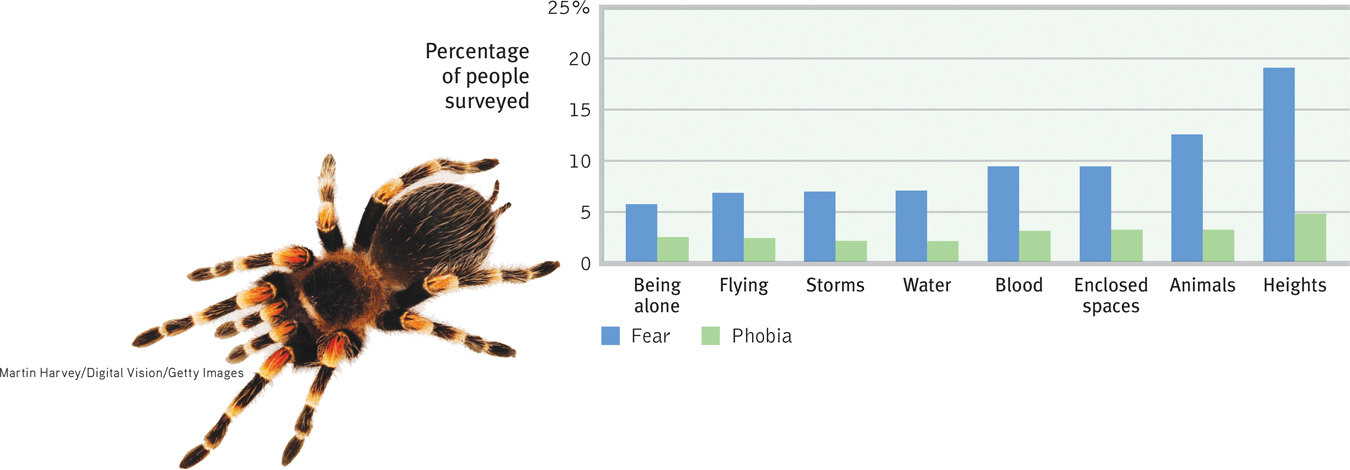50.1 Anxiety Disorders
50-
The anxiety disorders are marked by distressing, persistent anxiety or dysfunctional anxiety-
- Generalized anxiety disorder, in which a person is unexplainably and continually tense and uneasy
- Panic disorder, in which a person experiences panic attacks—sudden episodes of intense dread—and fears the unpredictable onset of the next episode
- Phobias, in which a person is intensely and irrationally afraid of a specific object, activity, or situation
Generalized Anxiety Disorder
For the past two years, Tom, a 27-
Tom’s unfocused, out-
The person may not be able to identify, and therefore relieve or avoid, the tension’s cause. To use Sigmund Freud’s term, the anxiety is free-
Women are twice as likely as men to experience generalized anxiety disorder (McLean & Anderson, 2009). This anxiety gender difference was reflected in a Gallup poll taken eight months after 9/11, when more U.S. women (34 percent) than men (19 percent) said they were still less willing than before 9/11 to go into skyscrapers or fly on planes. And in early 2003, more women (57 percent) than men (36 percent) said they were “somewhat worried” about becoming a terrorist victim (Jones, 2003).
Some people with generalized anxiety disorder were maltreated and inhibited as children (Moffitt et al., 2007a). As time passes, however, emotions tend to mellow, and by age 50, generalized anxiety disorder becomes fairly rare (Rubio & López-
Panic Disorder
For the 1 person in 75 with panic disorder, anxiety suddenly escalates into a terrifying panic attack—
hot and as though I couldn’t breathe. My heart was racing and I started to sweat and tremble and I was sure I was going to faint. Then my fingers started to feel numb and tingly and things seemed unreal. It was so bad I wondered if I was dying and asked my husband to take me to the emergency room. By the time we got there (about 10 minutes) the worst of the attack was over and I just felt washed out (Greist et al., 1986).
621
These anxiety tornados strike suddenly, wreak havoc, and disappear, but they are not forgotten. Ironically, worries about anxiety—

Charles Darwin began suffering panic disorder at age 28, after spending five years sailing the world. Because of the attacks, he moved to the country, avoided social gatherings, and traveled only in his wife’s company. But the relative seclusion did free him to focus on developing his evolutionary theory. “Even ill health,” he reflected, “has saved me from the distraction of society and its amusements” (quoted in Ma, 1997).
Smokers have at least a doubled risk of panic disorder (Zvolensky & Bernstein, 2005). They also show greater panic symptoms in situations that often produce panic attacks, such as when they hyperventilate (Knuts et al., 2010). Because nicotine is a stimulant, lighting up doesn’t lighten up.
Phobias
We all live with some fears. But people with phobias are consumed by a persistent, irrational fear and avoidance of some object, activity, or situation. Specific phobias may focus on animals, insects, heights, blood, or close spaces (FIGURE 50.1). Many people avoid the triggers, such as high places, that arouse their fear, and they manage to live with their phobia. Others are incapacitated by their efforts to avoid the feared situation. Marilyn, an otherwise healthy and happy 28-

 Figure 50.1
Figure 50.1Some common and uncommon specific fears Researchers surveyed Dutch people to identify the most common events or objects they feared. A strong fear becomes a phobia if it provokes a compelling but irrational desire to avoid the dreaded object or situation. (Data from Depla et al., 2008.)
Not all phobias have specific triggers. Social anxiety disorder (formerly called “social phobia”) is shyness taken to an extreme. People with this disorder have an intense fear of other people’s negative judgments. They may avoid potentially embarrassing social situations—
622
RETRIEVAL PRACTICE
- Unfocused tension, apprehension, and arousal are symptoms of______________________disorder.
generalized anxiety
- Those who experience unpredictable periods of terror and intense dread, accompanied by frightening physical sensations, may be diagnosed with a ____________ disorder.
panic
- If a person is focusing anxiety on specific feared objects or situations, that person may have a____________.
phobia